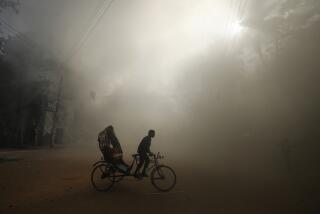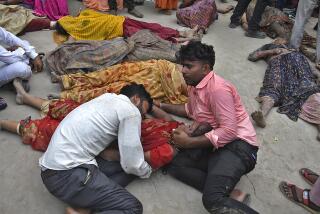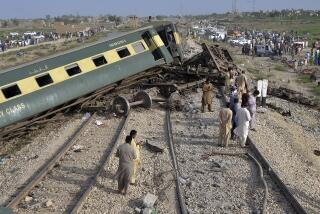110 Killed as Trains Collide in Bangladesh
- Share via
DHAKA, Bangladesh — A packed express train carrying worshipers to a religious festival crashed head-on into a local mail train Sunday in central Bangladesh, killing about 110 people and injuring as many 1,000 others, officials said. At least 100 of the injured were listed in critical condition.
“First there was an earth-shattering bang on our right,” said Naik Abdul Awal, who was one of about 250 soldiers taking part in army maneuvers nearby. “Then we looked and saw the carriages of the trains tossing up in the air like a giant balloon.”
“It was a terrible scene,” added another soldier, “with hundreds of passengers--men, women and children--shouting for help.”
The cause of the crash is under investigation, but some officials said that workers may not have been familiar with a new train signaling system.
The express train, headed for the southern port city of Chittagong, and the Dhaka-bound mail train were believed to be carrying as many as 2,000 people when they collided near the village of Maizdi Khan, about 20 miles north of the capital. But government officials at the scene said the exact number was difficult to determine since many people had been riding on the roofs of both trains as well as between the rail cars.
Soldiers helped police, firefighters and villagers pull 100 bodies from the mangled coaches, according to a senior railway official. Rescue officials estimated that as many as 350 more people may still be trapped inside or beneath the twisted wreckage of at least six mangled train cars.
Forhad Redza, railways manager for the Dhaka region, said workers using cranes and blowtorches in an overnight operation were trying to untangle the wreckage. Railway officials said the search for victims will resume at daybreak today. They said they expect the death toll to rise.
Witnesses put the death toll at 400. Their reports were backed by non-official medical personnel who had rushed to the scene shortly after the 7:30 a.m. collision.
“I saw a lot of bodies,” confirmed Ruhul Kuddus, an official with the Dhaka Polytechnic students’ union, who assisted in the rescue operation.
Cars ‘Jumped Into the Air’
“The death toll will be a lot higher than what officials are saying,” added Sirajul Huta, a 40-year-old doctor who suffered minor injuries in the crash. “The carriages jumped into the air and fell, and there was no way any of the people underneath could have survived.” He said he had counted about 330 bodies.
President Hussain Mohammed Ershad visited the accident site and ordered the army to take over the rescue operation. Police, military and railway security personnel overseeing the rescue work denied reporters access to the site, making it difficult to verify the conflicting casualty accounts.
Hundreds of anguished people, hoping to locate missing friends and relatives, converged on the site, which is in the middle of harvested rice fields.
Brother Mourned
“Oh, God! Give my brother back!” wailed 25-year-old Sunil Daniel, beating his chest and sobbing for his brother who was killed.
“Where is my boy? Give him back to me,” cried Afroze Banu, 40, as she sifted through the rows of bodies lying alongside the track amid toys, food cans and baggage from the wreck.
Islamic Gathering
Railway officials said many in the crash were worshipers involved in a pilgrimage at Tungi, where hundreds of thousands of Muslims have gathered for Biswa Ejtema, or World Congregation, which is Islam’s largest gathering next to the annual pilgrimage to Mecca in Saudi Arabia.
Hundreds of injured were taken to hospitals at Tungi, 5 miles north of the accident site, and to Dhaka, officials said. Ambulance and truck drivers said they had ferried about 750 injured people to hospitals and clinics in Dhaka, where doctors said they were running out of medicines.
Government officials immediately appointed a commission to investigate the crash. Some railway officials said operators may not have known how to work a signaling system that was installed on Tuesday and began operating on Friday along the affected rail line.
“Human failure and wrong signaling may have caused the two trains to come on the same track, leading to the collision,” a senior railway official said, requesting anonymity.
Jamail Ahmed, general manager of Bangladesh Railways, did not speculate on human failure but said the fault may have been the Norwegian-designed digital signaling system that eventually will control all trains on the nation’s 1,700 miles of tracks and cost $30 million.
“It might not have operated properly,” Ahmed said.
The accident disrupted rail traffic between Dhaka and major cities in the south and north.
“I just don’t remember anything. It was a big jolt and minutes later I found myself trapped inside a tilted coach,” said Kohinoor Begum, 40, as she waited for treatment at Dhaka’s Pangu Hospital.
Received Warning
Mohammed Sarker, a firefighter traveling on the local mail train who sustained a broken leg and stomach injuries, said he was told of the pending collision by another passenger who clambered off the roof and was about to jump from the ill-fated train.
“Before he could complete the sentence, there was a big bang and a jolt and we were all thrown overboard,” Sarker said. “Then I found myself buried under corpses.”
The official Bangladesh News Agency said the engineer of the Dhaka-bound train had been incorrectly told to proceed beyond Tungi, even through the tracks should have been clear for the 10-car express train, which was traveling about 60 m.p.h.
It reported that the driver of the eight-car mail train saw the oncoming express and managed to slow down before the locomotives slammed together.
The agency said it was unclear whether workers at the railway control room had dispatched the wrong signal to the local train.
It was the worst rail accident in the history of Bangladesh, exceeding a 1984 train fire that left 98 people dead and more than 200 injured near the western town of Jefford.
More to Read
Sign up for Essential California
The most important California stories and recommendations in your inbox every morning.
You may occasionally receive promotional content from the Los Angeles Times.










